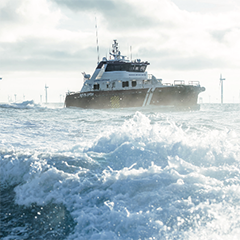What makes a good Crew Transfer Vessel (CTV)? SeaRenergy carried out an extensive study and shares the results with PES, highlighting ideas and suggestions based on design and offshore site challenges.
With the first offshore wind projects evolving in the Baltic Sea, SeaRenergy was recently asked for advice on suitable crew transfer vessels for these waters. The underlying question was about how to achieve the highest possible utilisation in terms of workability and crew welfare.
In order to properly evaluate all possible crew transfer vessel designs and sizes, weather data from two different locations were collected and analysed. Sufficient data through wave rider buoys and meteorological stations were gathered from two locations, situated in the German waters of the North Sea and Baltic Sea. Analysis in addition to the geographical circumstances led us to conclude that wave length is the most important factor when looking at CTV designs.
The North Sea has deeper waters with an average depth of around 95 m, direct connection to the Atlantic Ocean and therefore strong currents due to water streams and tides. A combination of these aspects enables a development of long and high wind waves as well as long and high swells.




























